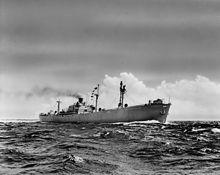
Andrew Benoni Hammond was an American lumberman. He developed the Missoula Mercantile Co. He built the Bitterroot Valley Railroad and the Astoria & Columbia River Railroad. He was president of the Hammond Lumber Co. and the Hammond Steamship Co.
Pacific Far East Line, also called PFEL in short, was a passenger and cargo shipping line founded in 1943 by Thomas E. Cuffe, in San Francisco, California. At the beginning he started by chartering foreign ships to run the lines in tramp trade. Later scheduled cargo services were added to the line. During World War II the South Atlantic steamship line was active with charter shipping with the Maritime Commission and War Shipping Administration.
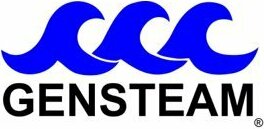
General Steamship Company was founded in 1920 in Houston, Texas, as a Private Company, and now goes by Gensteam since 1996. General Steamship Company has a fleet of cargo ships that operate worldwide. Gensteam has a Gensteam Operations Desk website that tracks all shipping logistics. Gensteam headquarters is now in San Francisco, California. General Steamship Company was part owner of American Pacific Steamship Company in New York state and Los Angeles during and post World War II. American Pacific Steamship Company was founded in 1942 in New York City, and was previously called Los Angeles Tanker Operators Inc. which operated T2 tanker ships. During World War II the General Steamship Company and American Pacific Steamship Company were active with charter shipping with the Maritime Commission and War Shipping Administration.
Weyerhaeuser Steamship Company was a cargo Liner company founded in Tacoma, Washington. Weyerhaeuser Steamship Company was founded by Weyerhaeuser Company in 1933. Weyerhaeuser is one of the largest lumber and paper companies in the United States. First called the Weyerhaeuser Timber Company which started with ships for towing logs in the Northwestern United States. Weyerhaeuser started Weyerhaeuser Timber Company with a ship he acquired in 1892. The log towing ship was a 140-foot sternwheeler built for the partnership, Weyerhaeuser and Denkman Company. In 1923 Weyerhaeuser added to ocean lumber cargo ship the SS Pomona and the SS Hanley. The two ships took lumber to the East Coast. In 1933 F. Weyerhaeuser starts the Weyerhaeuser Steamship Company and moves the headquarters to Newark, New Jersey. At the outbreak of World War II the US government orders the four Weyerhaeuser to take supplies to the British army in Egypt. The next year the other four company's ships are requisitioned by the War Shipping Administration. During World War II the Weyerhaeuser Steamship Company was active in charter shipping with the Maritime Commission and War Shipping Administration. During wartime, the Weyerhaeuser Steamship Company operated Victory ships and Liberty shipss. The ship was run by its crew and the US Navy supplied United States Navy Armed Guards to man the deck guns and radio. The most common armament mounted on these merchant ships were the MK II 20mm Oerlikon autocannon and the 3"/50, 4"/50, and 5"/38 deck guns. In 1942 the SS Potlatch and the SS Heffron were sunk by German U-boats torpedoes. After the war, Weyerhaeuser Steamship Company purchased four Liberty ships for intercoastal shipping service. In 1950 Weyerhaeuser Steamship Company purchases the Pacific Coast Direct Line and moves its headquarter from Newark to San Francisco. In 1962 the Weyerhaeuser Line is started and Weyerhaeuser Steamship becomes a division of Weyerhaeuser Company.

Calmar Steamship Company was a proprietary subsidiary of the Bethlehem Steel founded in New York City in 1927. Bethlehem Steel Company founded Calmar Steamship Company and other steamship companies after finding general shipping companies could not meet the company's needs in a timely manner. At the time Bethlehem Steel Company was the second-largest steelmaker in the United States and the world, only behind U.S. Steel. Calmar Steamship Company shipped Bethlehem Steel Company products from the Atlantic coast to the Pacific coast. On the return trip, Calmar Steamship Company would bring lumber products from the Pacific coast to the Atlantic coast. Calmar Steamship Company closed in 1976, as United States steel manufacture declined in the 1960s.

Interocean Shipping Company, Interocean Steamship Company of San Francisco was a subsidiary of the Bethlehem Steel Company founded in the late 1930s and closed in 1986.
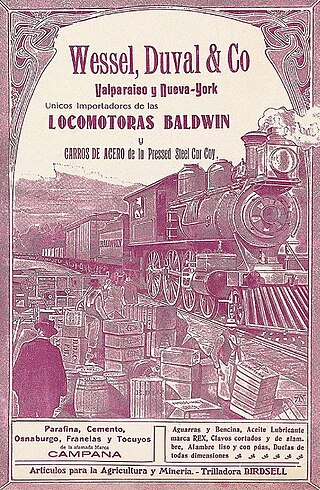
Wessel, Duval & Co. was founded in Boston, Massachusetts in 1825 Augustus Hemenway (1805-1876) as Hemenway & Co.. Augustus Hemenway started the shipping company to move his timber products to markets. Augustus Hemenway had timberland in Maine and started his schooner shipping company to take timber to Eastcoast ports. Later he opened a sugar plant in Cuba, his ships would take lumber to Cuba and bring back sugar. Next, he expanded his timber products to Argentina and other Western South American ports. By 1828 the company expanded to Valparaiso, Chile. Augustus Hemenway married into a Boston merchant family, marrying Mary Tileston (1820-1894) in 1840. In 1865 Héctor Beéche (?-1914) became a partner in the firm and a subsidiary company, Wessel, Duval y Cía, was founded in Chile by Charles P. Hemenway, Augustus's brother. Charles had acted on Augustus' behalf in other matters as needed and became a partner in 1870. T. Quincy Browne became a partner in 1870 also and for a few years the firm was called Hemenway & Browne. In 1875 William Muller joined as a partner, the name returned to Hemenway & Co. Augustus Hemenway died in Cuba in 1876. The partnership continued as Hemenway & Co. till 1885. In 1885 Muller retired and Carlos Wolff joined the partnership, the company name was changed to Hemenway, Beeche and Co.. In 1888 Peter "Perdo" M. Wessel (1851-1821) joined the partnership and the company name was changed to Browne, Beeche and Co.. In 1891 a New York City office was opened on 68 Brad Street, and most key workers moved to New York. The next year the Boston office was closed. In 1896 Wolff retired and in 1897 George L. Duval (1855-1931), W. L. Parker, and q became partners. With the new partners, the company name was changed to Beeche and Co.. In 1905 T. F. Budge and Robert Jaffray became partners. In 1907 the company name was changed to Wessel, Duval & Co. In the 1900s the company moved from sailing ships to steamships and opened a new West Coast Line at 47 Cedar Street, later moved to 1 Broadway. The West Coast Line started regular service from New York City to Valparaiso and Callao, Peru. West Coast Line main cargo was railroad and mining equipment to the expanding business in Chile and Peru, along with general cargo. The Chile rail firm, Ferrocarril del Llano de Maipo in Santiago used Wessel, Duval & Co. to import their railroad equipment in 1890. The return cargo from Chile was nitrate of soda. The West Coast Line chartered steamship as needed and was the US manager and agent for other shipping lines. West Coast Line also shipped UK and US coal for coal ships and to nations. For the West coast of South America both the steamer and sail ships used the starits of Magellan, this changed on August 15, 1914, with the opening of the Panama Canal, some routes began to use the Panama Canal cutting about 10,000 miles off the trip. The outbreak of World War I changed service, some charted ships were requisition by their home country, and the United States Shipping Board, gave some ships to the Line to operate for the War effort. Normal operations did not return till 1924, all post-war work have been completed. In from 1920 to 1932, West Coast Line was the US agent for Compania Sud Americana de Vapores, the South America Steamship Company of Chile. South America Steamship Company had luxury passenger service to and from Chile and New York City, on a fleet of luxury steamers: SS Renaico, SS Aconcagua and SS Teno. During World War II Wessel Duval & Company operated ships to support the war in the Pacific War and European theatre. Wessel, Duval & Co. operated some ships in the support of Korean war in the early 1950s. As ships aged and were retired Wessel, Duval & Co. has moved into media, advertising and marketing.
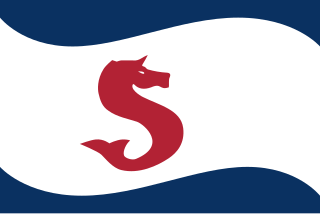
States Steamship Company, also called States Line and SSS, was started in 1928 by Charles Dant, in Portland, Oregon and later moved to the headquarters to San Francisco. Dant started the States Steamship Company to take his lumber product to market. He had a fleet of lumber schooners. Dant started by leasing ships from the United States Shipping Board - Emergency Fleet Corporation and founded the Columbia Pacific Steamship Company in 1919, Columbia Pacific Steamship Company routes were between Portland, Far East and Europe. In 1928 Dant merged the Columbia Pacific Steamship Company into the States Steamship Company. The Europe route ended in 1932 and the ship moved to a Philippines route. With the shift to container shipping in the 1960s and Dant's fleet of ships becoming older and obsolete, the company into bankruptcy in 1979. States Line operated four subsidies: Pacific-Atlantic Steamship Company, California Eastern Line founded in 1937 for lumber shipping, Oregon Oriental Line and the Quaker Line.
International Freighting Corporation of New York City was a US shipping company whose main operations was chartered shipping from United States ports to South America. International Freighting Corporation owned and operated an ocean liner service called American Republics Line, with service from New York to South America. In 1920 Scovil Company took over the International Freighting Corporation. Scovil Company was founded in 1802 in Waterbury, Connecticut, operating a large brass plant. By 1956 Du Pont and General Motors Corporation were the two stock owners of International Freighting Corporation and Du Pont purchased General Motors shares. In 1957 International Charter Services was founded and took over the accounts and contracts of the troubled International Freighting Corporation.
Sprague Energy, formerly Charles H. Sprague Company, C. H. Sprague and Son, is a Northeastern United States energy supplier. Charles H. Sprague Company was founded in 1870 in Boston by Charles H. Sprague. Charles H. Sprague Company delivered coal to New England cities from Newport News, Virginia. In 1905 Sprague expanded and opened the Penobscot Coal and Wharf Company in Searsport, Maine. This became the main supplier of US coal to Europe, particularly during World War II.

Merchants and Miners Transportation Company, often called M&M and Queen of Sea, was a major cargo and passenger shipping company founded in 1852 in Baltimore, Maryland. In 1852 is started with routes from Baltimore and Boston two wooden side wheelers ships. In 1859 M&M added two iron hulled steamers to its fleet. In 1866, post Civil War, M&M added routes to Providence, Rhode Island, Norfolk and Savannah, Georgia. In 1876 M&M purchased the Baltimore & Savannah Steamship Company add routes to Savannah, Jacksonville and Charleston. In 1907 the Winsor Line of Philadelphia's J. S. Winslow & Company of Portland, Maine was purchased, with seven steamships. The Winsor Line was founded in 1884 by J. S. Winslow. The Winsor Line first route was from Norfolk, Virginia to New England ports, supplying West Virginia coal. The Winsor Line sailing ship Addie M. Lawrence took ammunition to Europe during World War I. By World War II M&M had a fleet of 18 ships and add routes to Miami. With the outbreak of World War II the War Shipping Administration requisitioned Merchants and Miners Transportation Company fleet of ships for the war effort.

Blidberg Rothchild Company was a shipping company founded by Allan Blidberg and Sylvester Rothschild in New York City, United States. The shipping company has is start with a previous company Blidberg and Sagen Company founded by Tryggve Sagen and Allan Blidberg. Tryggve Sagen owned a ship in Oslo, Norway before coming to the United States in 1919. Sylvester Rothschild was born in 1896 in Sweden, he was a finance officer in Gothenburg. Rothschild came to America in 1919 and started the shipping company with Sagen. Blidberg and Sagen Company had shipping routes from New York to Scandinavian and Baltic ports. Sagen was president, Blidberg vice president and Sylvester Rothschild was the Secretary for the shipping company. Sylvester Rothschild was from Gothenburg Sweden, were he was the Vice-consul. In the 1930s Tryggve Sagen departed the company and the firm was renamed Blidberg Rothchild Company. The company had offices in Gothenburg and Norway. Blidberg Rothchild Company worked with an affiliated company Eastport Steamship Co of New York. Blidberg Rothchild Company also worked with an affiliated company Bridgeport Steamship Line of New York, a New Haven Railroad company.

J. H. Winchester & Company was founded by James Henry Winchester (1824-1913) in New York City in 1856. J. H. Winchester & Company was a cargo agent for the United States Shipping Board post World War I, in the 1920s. Winchester raised and born in Annapolis, Nova Scotia, Canada, on June 4, 1824. He moved to the United States in 1831 and settled in Eastport, Maine. Winchester completed the United States naturalized prossess on July 7, 1845 and became a US citizen. He moved to New York and became a ship captain. In New York became a partner in two brigantine sailing ships, one the Mary Celeste. The Mary Celeste was found hastily abandoned in 1872 between the Azores and Portugal. The abandonment is still a mystery today.
Polarus Steamship Company was founded in 1918, and again in 1923 in New York City by Tikhon Nicholas Agapeyeff (1891–1931). Tikhon N. Agapeyeff's 1918 frim, operated for only about two years. In March 1921, Agapeyeff sold the first Polarus Steamship Company to the C. M. Fetterolf Company for $250,000. The next incorporation in 1923 was a partnership of Agapeyeff, Marcel Levy, and Charles S. Dunaif. Marcel Levy was an attorney and Charles S. Dunaif was an exporter.
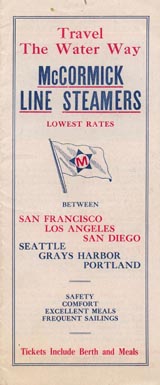
Charles R. McCormick Lumber Company was founded in 1908 by Charles R. McCormick in San Francisco, California. McCormick purchased a mill site in St. Helens, and formed the Helens Mill Company. To feed the mill McCormick's St. Helens Timber Company also purchased 4,000 acres of timber. In 1912 McCormick formed the St. Helens Lumber Company as parent company over Helens Mill Company and the St. Helens Timber Company. In 1912 McCormick expanded the company with a second sawmill, a creosoting plant and shipyard, the St. Helens shipyard. McCormick also expanded into San Diego, California with a railroad ties factory, to supply Santa Fe Railway and the mines of Utah, Arizona, New Mexico, and northern Mexico. At the San Diego site, he built a dock to unload his timbers. With the Great Depression slow down, McCormick closed dock at San Diego in April 1931.

Olympic Steamship Company was founded in Seattle, Washington, on August 22, 1925, by John Ambler, Charles A. Wallace, and William W. Shorthill. The Olympic Steamship Company had routes that served the Pacific Northwest. The Olympic Steamship Company had a fleet of about 4 ships. The Olympic Steamship Company was named after The Olympic Mountains in the state of Washington. John Ambler was an attorney, and Charles A. Wallace previously worked at Fisher Flouring Mills Company. William W. Shorthill was a clerk at The Pacific Steamship Company. After the start of the company, Joseph L. Carman, Jr., became vice president. Carman was previously president of Alaska Washington Airways. Olympic Steamship Company's first ship was an acquired 5,335-tonne tanker named the SS Dayton. Olympic Steamship Company renamed the Dayton the SS Olympic. The SS Olympic was built in 1907 as the Harport in South Shields, England. In 1936, Olympic Steamship Company entered into a joint venture with James Griffiths & Sons, Inc., as the Consolidated Olympic Company. The Consolidated Olympic Company offered a Long Beach, California, Seattle, and Tacoma, Washington, route on the Consolidated Olympic Line. The Consolidated Olympic Line was later renamed the Olympic-Griffiths Line. The Olympic-Griffiths Line acquired the 7,216-tonne cargo ship SS Olympic Pioneer, which was used on Pacific Northwest lumber and newsprint routes. The SS Olympic Pioneer also made two long voyages on the world trade route. The SS Olympic Pioneer then moved to a route from Puget Sound to Japan, moving US Army supplies. Olympic-Griffiths Line chartered ships for the other routes on the line. Ernest Clayton became president of the firm in 1940. Ernest Clayton previously worked for the McCormick Steamship Company. The Olympic Steamship Company was active in supporting the World War II effort.
W. R. Chamberlin & Company was a lumber and shipping company founded in 1915 by William Richmond Chamberlin in the Balboa Building in San Francisco, California. W. R. Chamberlin & Company main business was selling, brokering and shipping lumber and timber products from Portland, Oregon to the growing city of San Francisco and the San Francisco Bay area. By 1928 Chamberlin has four steamships to transport his lumber: the Barbara C, Phyllis, Stanwood, and W. R. Chamberlin, Jr. W. R. Chamberlin & Company was active in supporting the World War II efforts. W. R. Chamberlin & Company's ship the SS W.R. Chamberlin Jr put into service in the United States Navy and renamed USS Tackle (ARS-37). USS Tackle was damaged by an exploding mine on September 4, 1943 and too damaged to be repaired. Before founded W. P. Chamberlin & Company, Chamberlin Chamberlin was president of Byxbee & Clark Company, a lumber company in San Francisco.
Dichmann, Wright & Pugh, Inc. was shipping company founded in Norfolk, Virginia in 1925 by Vilh Dichmann, Bland Saunders Wright, Frank C. Pugh, Clint B. Sellers, and Alan Smith. Pugh had operated a company office in Philadelphia. Clint B. Sellers operated a company office in New York City. Saunders Wright was Dichmann, Wright & Pugh, Inc. President. Alan Smith was the company secretary and treasurer. Bland Saunders Wright worked in the Dichmann, Wright & Pugh, Inc. headquarters in Norfolk until his death on October 16, 1944. After Wright death, Alan Smith became president of Dichmann, Wright & Pugh, Inc and John M. Levick became assistant secretary and treasurer. With the start of World War II Dichmann, Wright & Pugh, Inc. supported the war effort.
William J. Rountree Company was a steamship agent and broker company founded by William J. Rountree in New York City in 1912. William J. Rountree Company was active in supporting the World War II effort by chartering and operating Liberty ships and Victory ships.
R. A. Nicol & Company was a shipping and ship broker company founded in New York City by Robert Alexander Nicol in 1923. Robert Alexander Nicol was born in England in 1880. Robert Alexander Nicol came to the United States in 1906 at the age of 26, from Liverpool, England. In 1290 Robert Alexander Nicol became a naturalized United States citizen. He started in the shipping business by working for the Oriental Navigation Company in New York City in 1916. R. A. Nicol & Company's office was at 17 Battery Place, New York City. R. A. Nicol & Company supported the World War II effort by operating United States owned ships.


